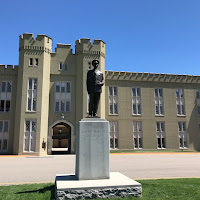VMI accepts its Confederate history in its many monuments, but there is a resounding self-realization that firmly acknowledges its problematic history while presenting a dogmatic desire to encourage the best of its students and to motivate its students to act for a communal good.
There are commemorative plaques littered throughout the school, one dedicated to Henry du Pont, a Union soldier; a memorial courtyard; a courtyard dedicated to Johnathan Daniels, a civil rights activist; monuments depicting Stonewall Jackson, George Washington, and George C. Marshall; and even a memorial to a long gone tree.
VMI accepts its past and its memorializations so as to preserve its history in full. Amongst the Gothic Revivalist, uniformly colored, and rigid architecture there is a fluidity of history that demonstrates an overwhelming appeal to humanity in recognizing both its mistakes and successes.
At the very least, that is how Col. Gibson presents the school's abundance of materials, and that is how it is presented to the school's freshmen during orientation. Whether or not these memorials effectively encourage an upright student body is somewhat difficult to say, but the mere presence of complex memorial interaction certainly seems to answer that question with a firm "yes."
That is not to say the school is perfect, and that is not to say VMI cadets did not laugh during Ruth Bader Ginsburg's talk in February, but as Col. Gibson acknowledged, there is a hope that the school's students realize their maturity outside of the comfort of their campus.





No comments:
Post a Comment